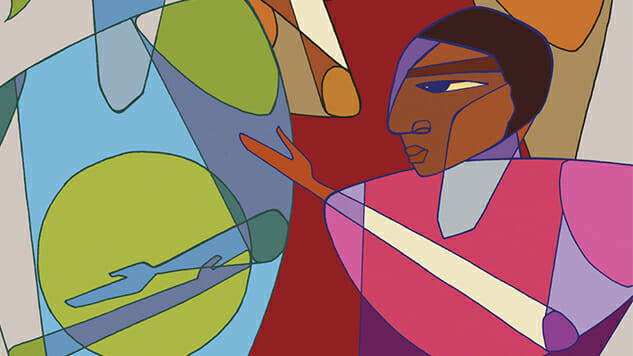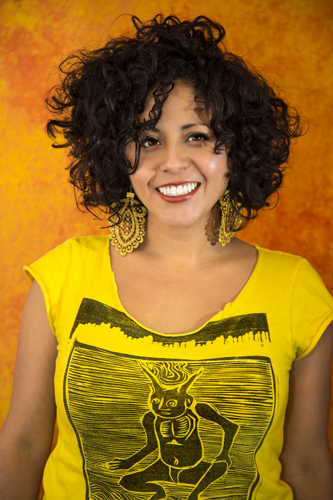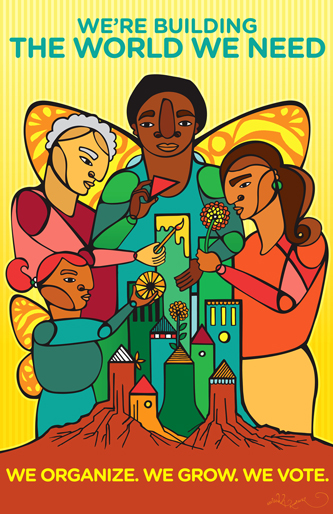Culture Strike: Art in Trump’s America
Oakland's Favianna Rodriguez’s Responds to Fear & Injustice with ‘Narratives of Joy’
Artwork courtesy of Favianna Rodriguez Visual Arts Features Favianna Rodriguez
“Migration is beautiful.” These three words give dual meaning to Oakland artist Favianna Rodriguez’s daffodil-colored print of a stained-glass-esque butterfly, the wings of which are appropriately filled with human likenesses. The pro-migration butterfly is just one of the many distinctive images used throughout the artist’s transformational body of politically and socially entwined works.
A first generation American who grew up in pre-gentrified Oakland during the genesis of hip-hop and some of the nation’s first anti-immigrant legislature, Rodriguez’s work has always been and still remains inextricably tied to the story of her multifaceted cultural experience. As the Trump administration continues to devalue arts and culture, Rodriguez’s work gains new purpose in the current political climate.
Paste spoke with the Afro-Peruvian master of multiples about using art and culture as a strategy to address migration, economic injustice, sexual freedom, and globalization.
Paste Magazine: You’ve been working both as an activist and as an artist for many years now. Did one role proceed the other?
Favianna Rodriguez: I grew up in one of the homicide capitals of the country in the 1980s. You could feel the effects of crack in our community, the effects of criminalization under Reagan—and for me especially, the effects of seeing that Latino/Latinx people like myself were either completely criminalized or completely invisible. I recognized fairly early that art, film and music were not really doing their part to tell my story as a Latina woman who grew up in the hood, the daughter of these people who brought with them a culture that was barely reflected in American culture at that time. So for me, the two really happened at the same time, although the path to becoming an artist, especially as the child of immigrants, was not necessarily easy.
Three years into college, when I was 21, I got pregnant, and I decided to have an abortion. I knew I did not want to be a mom, but it was at that moment that I really knew, once and for all, that I wanted to be an artist. So, it was around that time that I took my first art class at UC Berkeley, where I was invited to participate in a project at Self Help Graphics and Art in East L.A., one of the largest printmaking and nonprofit arts center dedicated to the production of Chicana/o and Latina/o art. I was able to participate in a master print portfolio with Chicana artists like Yolanda Lopez, Diane Gamboa, and Barbara Carasco. That was a huge turning point for me—I realized if I wanted to be an artist, I could not do it through the institution of college, especially one that was very white and Eurocentric. So I dropped out of school. And my art, from the beginning, was really a response to the injustices I began to feel so strongly.
Paste: What were some of the first big cultural events that made you go “Okay, I have to create art” and what were some of those earliest works?
Rodriguez: I started making political posters in 2001 after 9/11. That was when you really felt a notable shift in the national tone and I was like “Okay, I need to do anti-war posters.” My first poster read “Genocide Does Not Equal Justice,” which was soon followed by “Women of Color Against the War.” I can remember putting the first piece up in some of my first shows and having a lot of angry people approach me. They felt, when it came to the Iraq War, that 9/11 was clear reason for the war and asked how I could be so unpatriotic. I also realized that I needed to take on globalization in my work after following years of major protests like the Battle in Seattle. All these events and the air of nationalism that followed really inspired me to not only use my art, but to train myself further in the art of screen printing and the history of the political poster.

Growing up surrounded by the remnants of the Chicano/a art movement, I had the chance to learn screen printing from members of my community who had been trained by very famous Chicano/a muralists. When I began to learn about the tradition of the anti-war poster, the feminist poster, the Cuban political poster, it just blew my mind. So I new where to begin—my foundational years in art making were to be spent creating the social justice poster.
Paste: How did your message change from post 9/11 to the present?
Rodriguez: As I began to evolve with my work, I noticed that I had been reactive to the very debilitating injustices happening around me. I was not necessarily creating visionary narratives that I am now—narratives of joy, opportunity, and pleasure. It was really around 2011-2012 that I especially began to notice how the demoralization of our communities had left a real void when it came to politically and socially engaged art. I realized we were missing work that was about our joy, our resilience, and our power. And when I finally began to come out about my abortion in 2012, I especially noticed the way in which fear or suffering-based narratives—pain-based narratives, actually that’s the word, pain was really what dominated and I wanted to do something else.

Just days after coming out about my abortion, I realized what I did and did not want. I didn’t want people to feel sorry for me. I wanted people to see I made a good choice, a choice that made me feel empowered. And I realized I wanted to do the same with other peoples’ stories. I began to make art that was inspired by my own vision for the future, and that’s when I began doing work about Pussy Power, Migration is Beautiful, about freedom as it relates to mass incarceration and immigrant detention.
Paste: And what about your aesthetic? From 2001 until now, there’s a clear move from traditionally-inspired prints to abstract figurations. How does your work challenge assumptions that there’s a set aesthetic for political art?
Rodriguez: I eventually began to realize that I was in many ways stuck in an aesthetic I had inherited. I wanted to break from that aesthetic, not to abandon it, but to show that there’s more than one way to make art about social justice. So I started using more monotypes and collages and making works that were more abstract. I began to experiment more with color and figures. If you look at Latino culture overall, it’s very colorful and so I inherited that tradition. The turquoises, yellows, and pinks combined with the oranges and reds that were such a strong part of my culture really made for a palette that felt authentically me—it’s a nod to my ancestry.

I actually just had a show, and in my show I had these abstract compositions that were about biodiversity and linking that to cultural diversity. Monoculture is a huge threat to our way of interacting and so I used some themes in nature to create these abstract works. And somebody told me “You know, I’m not crazy about that piece.” And I was like “Really? Why?” and they just said “Because it’s not as bold.” And it made me wonder “What does bold mean to this person? Is there just one way to be bold?” And what I realized was when we say political or social justice art, people think they know what that looks like and I want to be the one to say “No, you actually don’t know what it fully looks like” because I’ve seen the limits and the way most are constructing activism working within art, and we need to think bigger.
Paste: You’re not only an artist, but an educator as well. Why is that work is so important, especially in today’s political climate?
Rodriguez: My goal as an educator is to replace the old narrative of the artist as the “starving artist” whose real value is only uncovered once they’re dead. It’s not true and we can alter that narrative, starting with “the artist as change,” or “the artist who builds new systems through their creativity.” By 2011, I really began to accept that institution building was an extension of my own practice. I realized, yes, I was creating art, but I was also building power, and realizing that was what led me to found Culture Strike with my friend and author Jeff Chang. The purpose wasn’t just about the creation of objects and artistic intervention, it was also about the creation of power and utilizing communication to shift public sentiment. My job is to help artists tap into their power and understand the role they possess in helping society move away from viewing art as a nicety towards viewing art as a necessity.
Paste: How do we move forward, as artists and as citizens, in the age of Trump?
Rodriguez: Honestly, I feel like we’ve regressed, and as a culture maker, it is very upsetting that I now have to return to the work of doing some basic education on my own humanity. Like we have this “hero” for some who wants to build a wall and protect his fellow white people. It’s illogical and irrational and, nevertheless, has been very effective. For me as an artist, it’s really made me realize the power of storytelling and it’s precisely why we need to respond with our own stories and narratives. It’s really like white supremacy’s last stand, so it’s like “Okay, time to pull out all the tools here, like do I really have to get out all these old posters and use them again?”
But at the same time, what I really want to be doing is telling complicated, complex stories of my own experience growing up in Oakland, a place that’s been massively gentrified. It’s going to be about my abortion, my sexual promiscuity, my queerness, and my refusal to do things in the way that we’re supposed to do things—you know, go to college and get a degree, well I dropped out. I want there to be room for these stories, so I’ve been reinvigorated in a sense to create stories like this—joyful stories that have the power to stand up a very dangerous story. Look at Moonlight for instance, we were presented with the story of a boy growing up in the hood surrounded by drugs and addiction. People think they already know that story, but they don’t.
Leah Rosenzweig is a regular Paste Arts contributor.